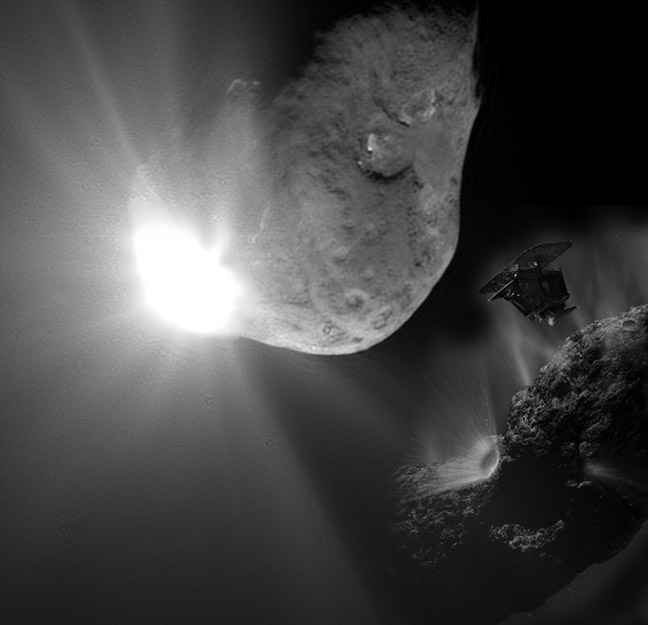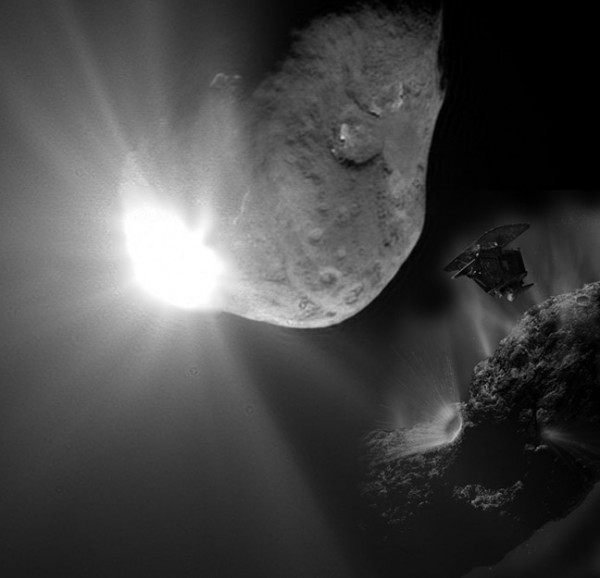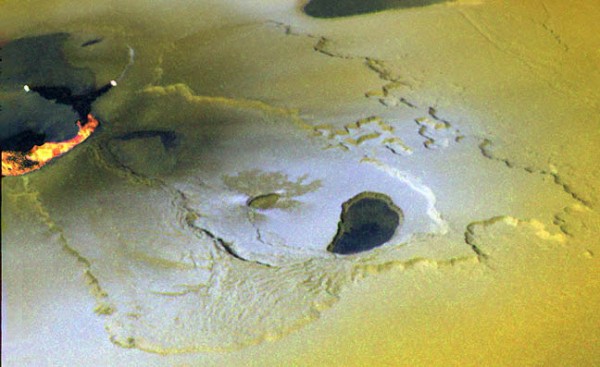holoscience.com | The ELECTRIC UNIVERSE®
A sound cosmology for the 21st century

First Evidence of Comet Ice – What Does it Mean?
“There is more riding on this mission than may be apparent from regular news sources. At issue is the assumption of an electrically neutral universe, upon which every conventional astronomical theory rests. The story of the formation of the solar system from a cloud of gas and dust – and comets as the leftovers – is a work of fiction that has never predicted anything useful. Like Alice chasing the White Rabbit down its hole, each surprising new discovery has resulted in an increasingly absurd story.”
– Wal Thornhill, The Deep Impact of Comet Theory

Before the Deep Impact probe struck comet Tempel 1, I wrote:
“There is a high probability that scientists will find less water ice and other volatiles than expected, both on the surface and beneath the surface of Tempel 1.”
As reported on February 2, 2006, NASA’s Deep Impact Team claims to have the first definitive evidence of small patches of surface ice on a comet. It is woefully inadequate to explain the water signal detected in the comet’s coma.
New Scientist reports:
“the water ice is present in surprisingly small amounts, covering less than 1% of Comet Tempel 1’s surface. The finding suggests the comet’s surrounding cloud of gas and dust may largely be fed by underlying ices, rather than by gas streaming off its surface.”
The technical report in the journal Science is more specific:
“A surface area of 1.3 km2 of 100% water ice is therefore required to account for the ambient outgassing of water, … The observed 0.5 km2 of 6% water ice, ~0.03 km2 of pure water ice, is significantly less than this. Thus, while they may be associated with natural outbursts, the water ice deposits detected on the surface of Tempel 1 reported here are not the dominant sources of outgassing. Therefore, assuming that the distribution of ice on the unobserved parts of the nucleus are broadly similar to those observed, the ambient outgassing observed for Tempel 1 likely has significant sub-surface sources.”
The assumption that most of the water detected in the comet’s coma probably comes from water ice buried out of sight inside the comet seems quite reasonable. After all, where else could it come from?
But what does this discovery really mean? “We have known for a long time that water ice exists in comets, but this is the first evidence of water ice on comets,” said Jessica Sunshine, Deep Impact co-investigator and lead author of the Science article. The findings help satisfy one of the major goals of the Deep Impact mission: Find out what is on the inside – and outside – of a comet.
Aren’t we in danger here of assuming what we have yet to prove? How does a little ice on the surface of Tempel 1 tell us what is inside the comet? “We have known for a long time” that solar heating causes water ice to sublimate from the comet surface into the vacuum of space. That doesn’t seem to be happening. So how can most of the water be coming from inside the comet? Maybe our story of comets is wrong. Is there another source for the signal we interpret as water from the comet?
Unfortunately, scientific objectivity fails when firmly held beliefs, and funding, are at stake. Almost every news report about comets carries the benediction that comets are “Rosetta Stones” that, once decoded, will tell the story of the Earth’s formation. This comet myth regards them as the “icy remnants” left over from the birth of the solar system. They are “stored” and maintain their primordial ices for billions of years in a cold outer region of the solar system known as the Oort cloud. Comets must, therefore, be composed of loosely bound ices and dust. Somehow, billions of years later, some comets are “perturbed” into the inner solar system for our amusement, consternation and puzzlement.
Never mind that the Oort cloud has never been observed. And comet orbits deny such an unlikely origin. Now the ices are proving difficult to find. Despite this, the inertia of prior beliefs insists that all new discoveries be interpreted according to the myth.
Astronomers know next to nothing about comets and their origins. It is all guesswork based on the single problematic theory of comet formation in an imagined early solar nebula. It is a theory that was described by the astronomer Ray A. Lyttleton as “a piece of trash.” In fact, Oort himself maintained that an origin for comets inside the solar system, perhaps connected with the formation of the asteroid belt, was more likely. It is a possibility eloquently argued by the astronomer Tom Van Flandern in his book, Dark Matter, Missing Planets & New Comets.
How do we know water is coming from a comet?

Fred Whipple, in his book The Mystery of Comets, writes:
“the inner coma of a comet is a chemical factory! This leaves us confused as to whether the materials we detect come unchanged directly from the nucleus or were manufactured near the surface. Fortunately, the tools for analysing this horrendously complicated problem have become available in recent decades.”
Supercomputers are used to track more than a hundred species of atoms and molecules and a thousand and more possible reactions among them. The spectroscopic observations of the comet’s coma are then used to estimate what ices and minerals are coming from the comet nucleus. Whipple continues:
“From our vantage point on Earth, which is so distant from comets, we can observe only the end products of the chemical factory after they have escaped hundreds or thousands of kilometres into space, where the gas is so rare that collisions no longer count. Thus the complicated gas-phase chemistry disguises the composition of the original ices in a comet.”
But if this concept is wrong then the data from Deep Impact is being misinterpreted and misrepresented to the public.
There is another possibility that remains unexamined. It takes account of the obvious electrical nature of comets, which is the only model to successfully predict what would be found by the Deep Impact experiment.
The flaw in the conventional approach is that only gas-phase chemical reactions and reactions induced by solar radiation (photolysis) are considered. The far more energetic molecular and atomic reactions due to plasma discharge sputtering of an electrically charged comet nucleus are not even contemplated [see below]. Yet this model solves many comet mysteries that are seldom mentioned.
The hydroxyl radical, OH, is the most abundant cometary radical. It is detected in the coma at some distance from the comet nucleus, where it is assumed that water (H2O) is broken down by solar UV radiation to form OH, H and O. It is chiefly the presence of this radical that leads to estimates of the amount of water ice sublimating from the comet nucleus. The comas of O and OH are far less extensive than the H coma but have comparable density.
The negatively charged oxygen atom, or negative oxygen ion, has been detected close to cometary nuclei. And the spectrum of neutral oxygen (O) shows a “forbidden line” indicative of the presence of an “intense” electric field. The discovery at comet Halley of negative ions puzzled investigators because they are easily destroyed by solar radiation. They wrote, “an efficient production mechanism, so far unidentified, is required to account for the observed densities.” And the intense electric field near the comet nucleus is inexplicable if it is merely an inert body ploughing through the solar wind.
Let’s see how the electrical model of comets explains these mysteries. The electric field near the comet nucleus is expected if a comet is a highly negatively charged body, relative to the solar wind. Cathode sputtering of the comet nucleus will strip atoms and molecules directly from solid rock and charge them negatively. So the presence of negative oxygen and other ions close to the comet nucleus is to be expected. Negative oxygen ions will be accelerated away from the comet in the cathode jets and combine with protons from the solar wind to form the observed OH radical at some distance from the nucleus.
The important point is that the OH does not need to come from water ice on, or in, the comet. Of course, some water is likely to be present on a comet or asteroid. It depends upon their parent body. And since there are many moons in the outer solar system and the rings of Saturn with copious water ice, we may expect some smaller bodies like comets and asteroids to have some too. But what is obvious from the closeup images of comet nuclei is that they look like dark, burnt rocks. They do not look icy. Their appearance fits the electrical model and not the poorly consolidated dirty ice model.
In 1980, a report on cometary science in the journal Nature outlined some of the mysteries and anomalies. It concluded: “cometary scientists need to consider more carefully whether H2O-ice really does constitute a major fraction of comet nuclei” The warning went unheeded. So the myth lives on and the mysteries grow with each new discovery.
One of the mysteries about comets is their gigantic enveloping comas. Multiple “fountains” directed from the comet nucleus toward the Sun are used to explain them. The solar wind, with its magnetic field pushes the fountains back to form a dusty coma and tails. The coma, visible in reflected light, may measure hundreds of thousands of kilometres across. Early in 1970, comets were first observed in UV light from fluorescing hydrogen atoms and found to have an “almost unbelievable” coma of hydrogen atoms (15 million km diameter in the case of comet Bennett). How can a small body, a few kilometres across, entrain an envelope of hydrogen atoms many millions of kilometres in diameter? But there were mysteries within this mystery. Small and unexciting comets had comas as large as the more active comets. Yet the outgassing from a comet nucleus should vary with its surface area.
The first important thing to note about the hydrogen coma is that we are talking about neutral hydrogen atoms. That is, a proton combined with an electron. The solar wind provides the protons, which are attracted to the negatively charged comet. The comet has copious electrons and negative ions, which are being ejected from the nucleus in cathode jets. (The emission of matter from comets in the form of jets is another mystery for the standard model of comets). Bring the protons and electrons together and you have a giant envelope of hydrogen atoms about the comet. The size of the coma is essentially an electrical plasma phenomenon, independent of the size of the comet nucleus.
The activity in a comet coma should be viewed in terms of low-pressure gas discharge phenomena, not simply gas-phase chemistry and photolysis. If more evidence were needed that this is so, we need only remember the baffled surprise of astronomers when an orbiting x-ray telescope was accidentally pointed at a comet and strong x-ray emissions found. An explanation was cobbled together after the discovery. It involved the recombination of solar wind ions with electrons from the comet. But that constitutes an electric current between the comet and the solar wind.
Electric currents in plasma take a filamentary form. So it is instructive to record some of the comments made when the US International Cometary Explorer (ICE) spacecraft flew by the comet Giacobini-Zinner. John C. Brandt, comet scientist for the ICE mission, said, “The extremely fine structure is a surprise, the lack of a traditional bow shock is a surprise and the richness of the high-energy phenomenon [sic] is a surprise.” Robert Hynds, head of the proton detector team, reported that in the comet tail, “Ions around the spacecraft were very highly collimated in narrow beams …” Other spacecraft have detected these current filaments in comet tails stretching across the solar system.
A charged comet nucleus moving through the solar plasma will form a number of plasma sheaths or double layers, where the comet’s electric field is concentrated. The Giotto mission to comets Halley and Grigg-Skjellerup were surprised by their sharp plasma boundaries and one “mystery” boundary. There should be no mystery when they are considered as electrical plasma sheaths and not simply mechanical “bow shocks.” The so-called “near nucleus ion pile-up” is simply a manifestation of a cometary plasma sheath, or double layer. It is a region with a strong electric field and consequently capable of generating strong x-rays. The cometary x-rays were found coming from a region that didn’t conform to simple hydrodynamic collision calculations. It was remarked that it was like finding the shockwave from a supersonic aircraft several kilometres to one side of the aircraft. A plasma sheath is controlled by electromagnetic forces and is not expected to conform to bow-shock physics.
Surface Erosion
Sputtering is recognized as one of the forms of space weathering, a process that changes the physical and chemical properties of airless bodies, such as asteroids and our Moon. It is a slow, diffuse effect due to the mechanical impact of solar wind ions. Cathode sputtering, on the other hand, disintegrates the substance of a cathode by the bombardment of energetic ions in an electric discharge. It concentrates the cathode erosion in small spots, which give rise to rapid surface erosion in the form of steep-walled craters. Movement of the cathode arc creates a familiar “etched” look to a surface. The sputtered material is accelerated from the cathode in well-collimated cathode jets. Cometary jets and the so-called “volcanoes” on Io are prime examples.

Significantly, a paper in Science, last October, argued that shocks caused by ion sputtering sharpen steep surface features. It was found that high slopes propagate over large distances without dissipating the steepest features. Also cathode arcs tend to impinge on sharp edges because of the higher electric field found there. The white spots seen on comets Wild 2 and Tempel 1 should be considered in this way. It would account for the surprising sharp features and craters seen on comets, particularly on comet Wild 2. Surface heating and sublimation, on the other hand, tends to soften sharp features.
There are many other mysteries about comets and their behavior. One that deserves mention, following the analogy between the surface of Io and comet nuclei, is the mystery of very short-lived diatomic sulfur, S2, found only in comets IRAS-Araki-Alcock and Hyakutake (both came very close to Earth). In the book Comet Science: The study of remnants from the Birth of the Solar System by Crovisier and Encrenaz, we find:
“It is not known what might be the origin of this molecule. Sulfur will only sublime at relatively high temperatures, which would not generally be attained on cometary surfaces or cometary grains. Moreover the equilibrium form of its vapor is S8 rather than S2. The origin of sulfur in these comets thus remains enigmatic.”
It is no more enigmatic than the pizza-colored moon of Jupiter, Io, which has powerful cathode jets operating continuously somewhere on its surface. The other Galilean moons of Jupiter have copious water ice on their surfaces. So it would not be asking much to suggest that Io also once had a predominantly water ice surface. The interesting possibility is that two oxygen atoms, removed from water molecules by a cathode arc, would be in a sufficiently energized state to combine to form an atom of sulfur. The sulfur takes a colorful molecular form in the cathode jet before returning to the surface of Io. Precisely the same process on a comet could provide the “enigmatic” sulfur.
The discovery of only a little water ice on the surface of a comet should not allow researchers to simply push the problem out of sight in order to maintain their myth about comets. To suggest that the water ice has come from inside the comet raises more problems than it solves. And it does nothing to clear up the many other mysteries of comets.
Wal Thornhill